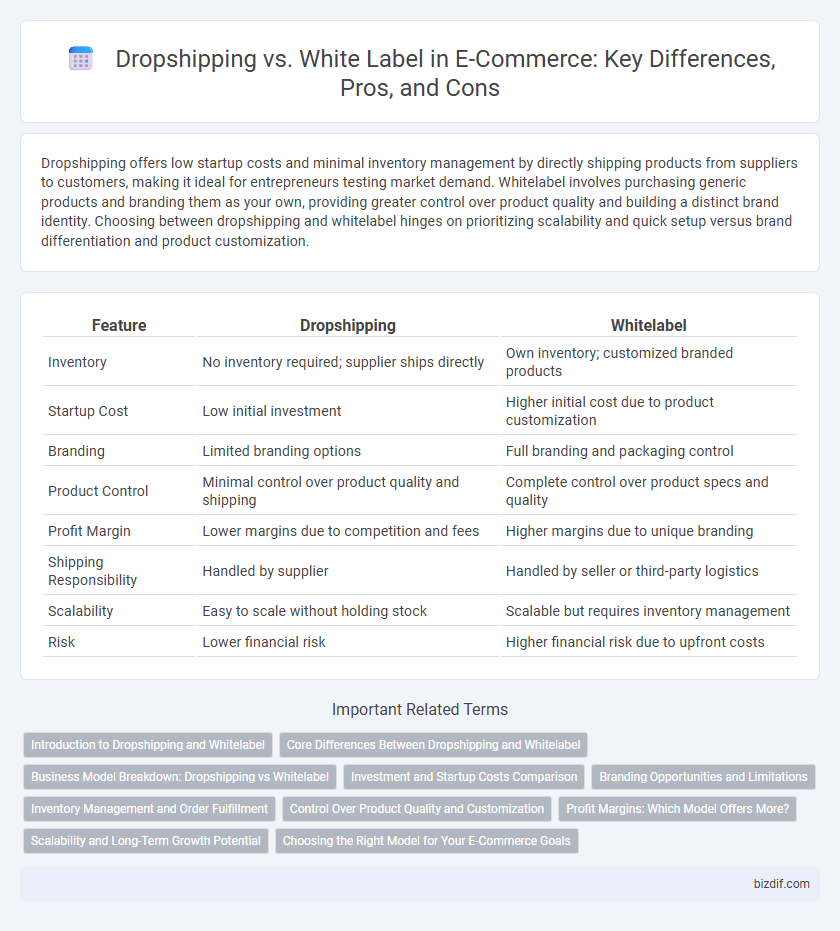Dropshipping offers low startup costs and minimal inventory management by directly shipping products from suppliers to customers, making it ideal for entrepreneurs testing market demand. Whitelabel involves purchasing generic products and branding them as your own, providing greater control over product quality and building a distinct brand identity. Choosing between dropshipping and whitelabel hinges on prioritizing scalability and quick setup versus brand differentiation and product customization.
Table of Comparison
| Feature | Dropshipping | Whitelabel |
|---|---|---|
| Inventory | No inventory required; supplier ships directly | Own inventory; customized branded products |
| Startup Cost | Low initial investment | Higher initial cost due to product customization |
| Branding | Limited branding options | Full branding and packaging control |
| Product Control | Minimal control over product quality and shipping | Complete control over product specs and quality |
| Profit Margin | Lower margins due to competition and fees | Higher margins due to unique branding |
| Shipping Responsibility | Handled by supplier | Handled by seller or third-party logistics |
| Scalability | Easy to scale without holding stock | Scalable but requires inventory management |
| Risk | Lower financial risk | Higher financial risk due to upfront costs |
Introduction to Dropshipping and Whitelabel
Dropshipping allows e-commerce sellers to list products without holding inventory, fulfilling orders directly through suppliers who ship items to customers. Whitelabel involves selling products manufactured by a third party under the retailer's brand, offering greater control over branding and customer experience. Both models minimize upfront investment but differ in inventory management, branding opportunities, and profit margins.
Core Differences Between Dropshipping and Whitelabel
Dropshipping involves selling products directly from suppliers without holding inventory, whereas whitelabel requires purchasing products in bulk and rebranding them as your own. Dropshipping offers low upfront costs and minimal risk, while whitelabel demands higher initial investment but allows greater control over product quality and brand identity. Core differences include inventory management, branding opportunities, and profit margins, with dropshipping prioritizing ease of entry and whitelabel focusing on brand building and product customization.
Business Model Breakdown: Dropshipping vs Whitelabel
Dropshipping eliminates inventory management by shipping products directly from suppliers to customers, reducing upfront costs and operational risks. Whitelabel involves purchasing products in bulk, rebranding them for resale, offering greater control over branding and quality but requiring inventory investment. Understanding these key differences helps entrepreneurs choose between low-entry barriers with dropshipping or brand ownership and scalability with whitelabel models.
Investment and Startup Costs Comparison
Dropshipping requires minimal upfront investment since inventory is managed by suppliers, eliminating the need for large stock purchases and warehousing expenses. Whitelabel businesses demand higher startup costs due to product sourcing, customization, branding, and inventory management. Entrepreneurs seeking lower financial risk often prefer dropshipping, while whitelabel offers greater control over product quality and brand identity at a higher initial cost.
Branding Opportunities and Limitations
Dropshipping offers limited branding opportunities as products are sourced directly from suppliers, restricting customization and brand identity development. Whitelabel enables extensive branding by allowing businesses to rebrand generic products with their own logos, packaging, and marketing strategies, enhancing customer loyalty. However, whitelabel requires higher upfront investment and inventory management compared to the low-risk, minimal upfront costs of dropshipping.
Inventory Management and Order Fulfillment
Dropshipping eliminates the need for inventory management by relying on suppliers to store and ship products directly to customers, reducing upfront costs and storage risks. In contrast, whitelabel e-commerce requires managing inventory under your brand, allowing greater control over stock levels, packaging, and quality assurance but increasing storage and fulfillment responsibilities. Efficient order fulfillment in dropshipping depends heavily on supplier reliability, while whitelabel models demand robust logistics coordination to maintain brand reputation and customer satisfaction.
Control Over Product Quality and Customization
Dropshipping offers limited control over product quality and customization since suppliers manage inventory and fulfillment, often resulting in uniform products with minimal branding options. Whitelabel allows e-commerce businesses to maintain full control over product quality and customization by producing or sourcing products under their brand, enabling tailored features and packaging. This control enhances brand identity and customer satisfaction by ensuring product standards align with brand promises.
Profit Margins: Which Model Offers More?
Dropshipping typically offers lower profit margins, ranging from 10% to 30%, due to reliance on third-party suppliers and increased competition. Whitelabel products allow for higher margins, often exceeding 50%, as businesses control branding and pricing with direct manufacturing or private labeling. Choosing whitelabel enhances profitability by reducing costs and increasing perceived product value in the e-commerce market.
Scalability and Long-Term Growth Potential
Dropshipping offers low upfront costs and easy inventory management, making it scalable for beginners, but long-term growth can be limited due to supplier dependency and lower profit margins. Whitelabeling requires more initial investment and control over product quality, which enhances brand loyalty and allows for higher margins, supporting sustainable long-term growth. E-commerce entrepreneurs aiming for scalability and brand equity often prefer whitelabel models to build lasting customer relationships and expand market presence.
Choosing the Right Model for Your E-Commerce Goals
Dropshipping offers low upfront costs and minimal inventory management, making it ideal for testing product markets quickly with less financial risk. Whitelabel allows for brand customization and higher profit margins by selling products under your own brand, requiring more control over sourcing and quality. Selecting the right model depends on your e-commerce goals, whether prioritizing scalability and brand identity or flexibility and lower initial investment.
Dropshipping vs Whitelabel Infographic

 bizdif.com
bizdif.com